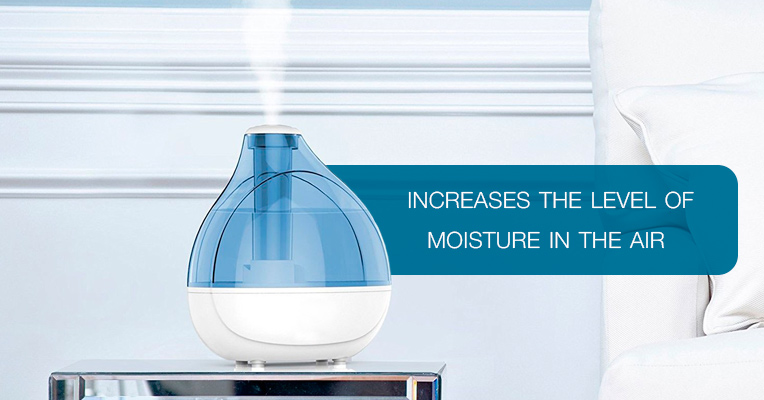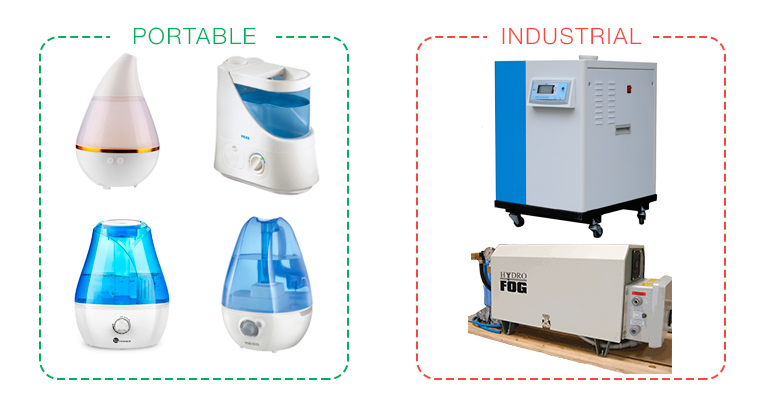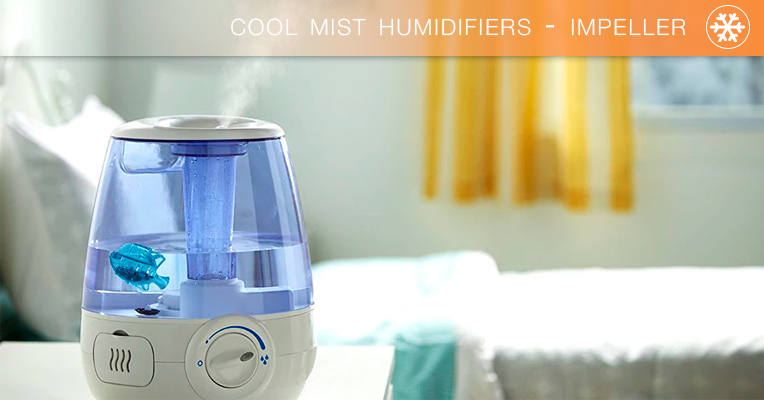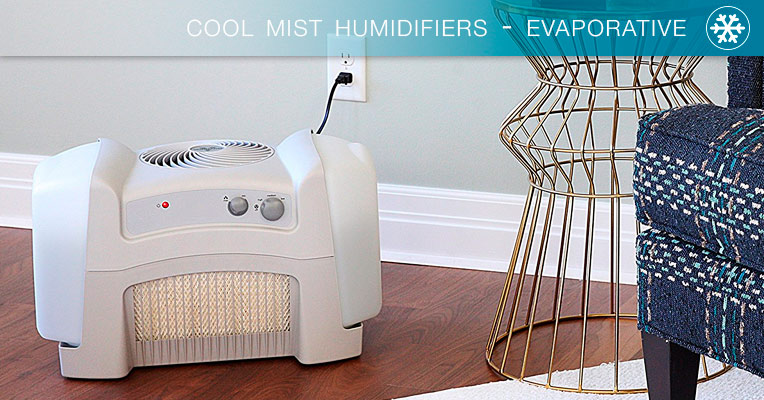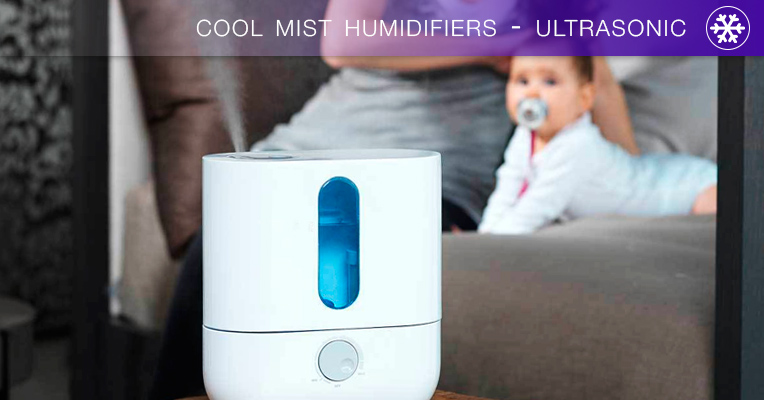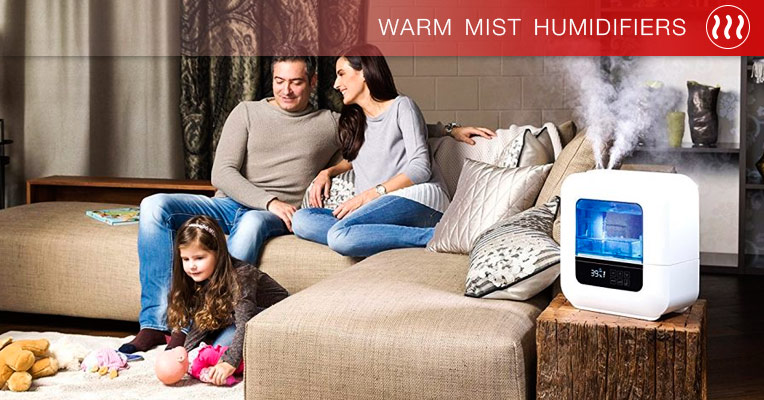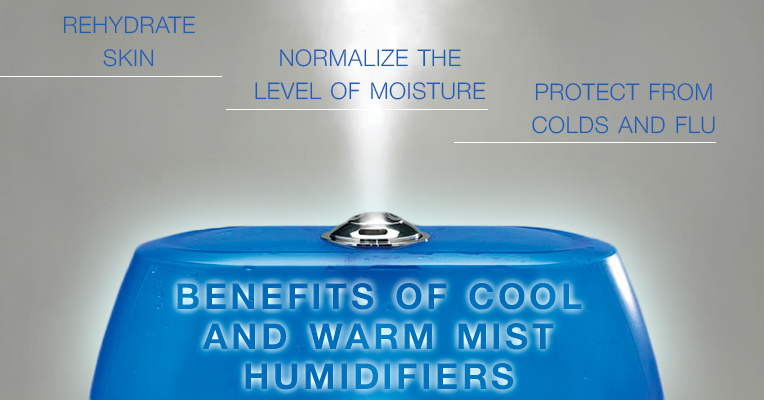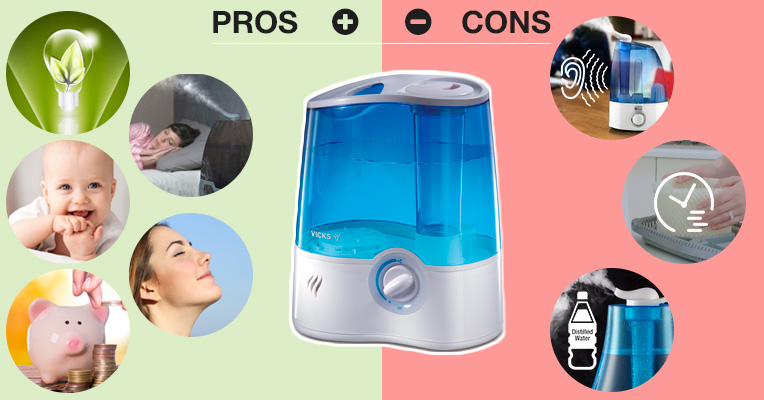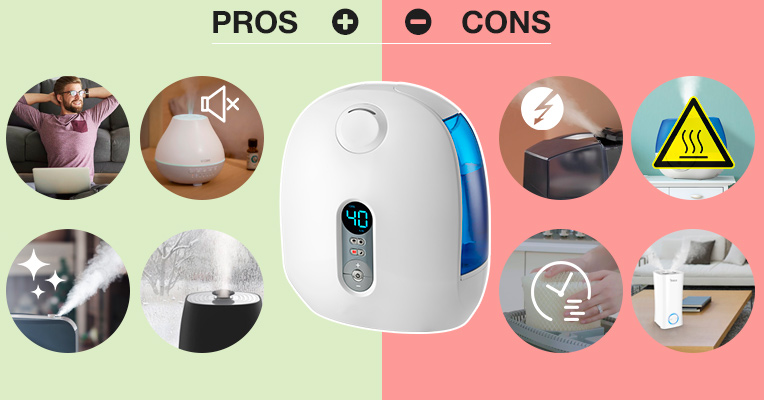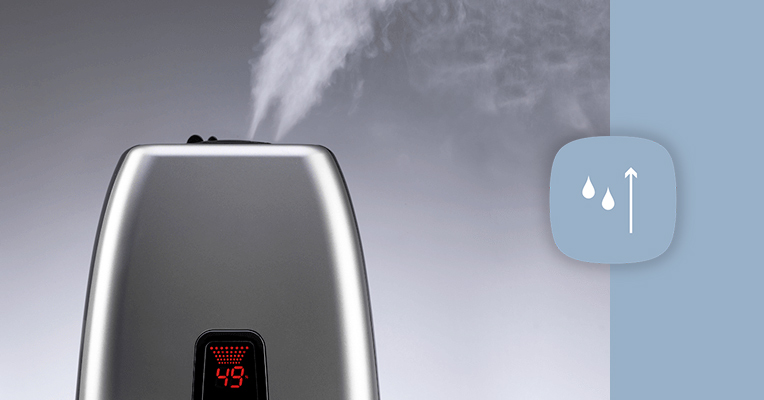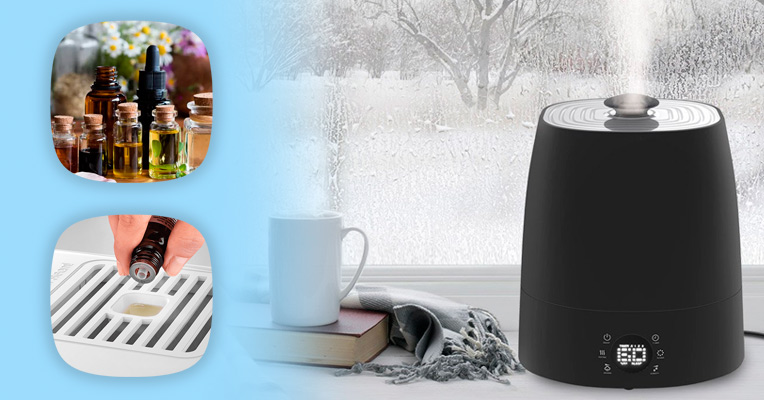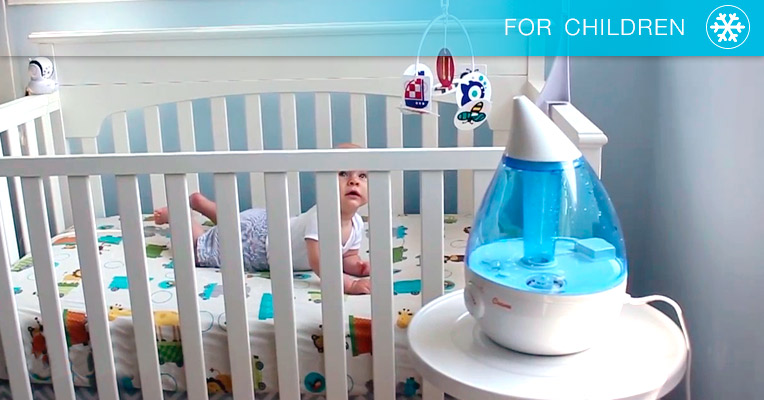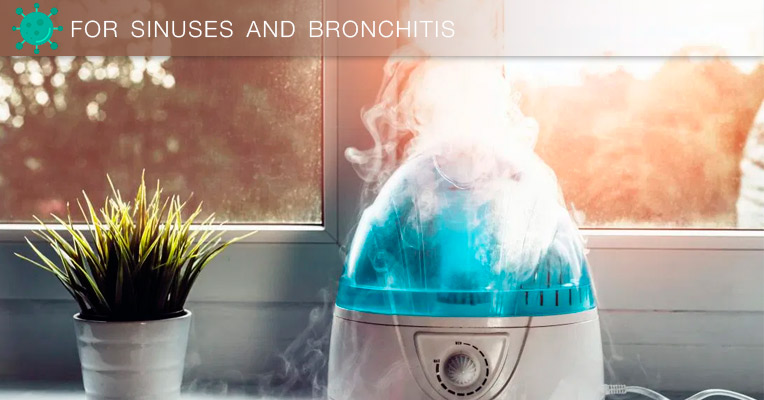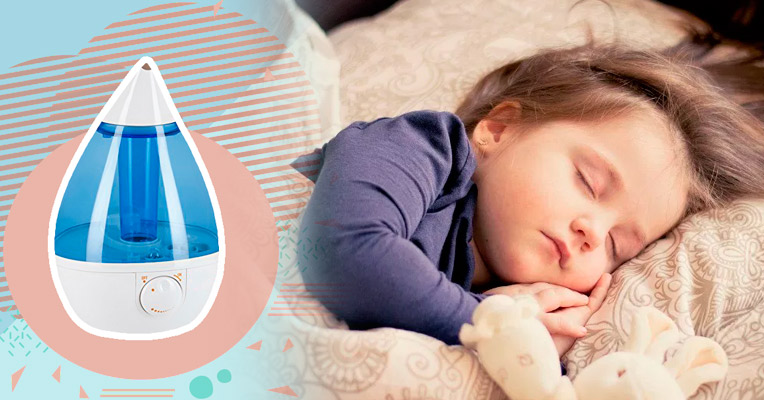Generally speaking, a humidifier is a device that increases the level of moisture in the air. As you know, the air we breathe contains many different gases (oxygen, nitrogen, carbon dioxide) and water vapor. The humidity level is determined by the amount of this vapor in the air. When its volume reduces, the air becomes dry. That's where a humidifier comes in. It helps normalize the level of moisture in the air, making it humid enough for comfortable breathing. In case the amount of vapor increases greatly and the air becomes too moist, a dehumidifier is used, a device that allows quickly removing excess moisture from the air to prevent the appearance of fungi, mold, etc.
The principle of operation of a humidifier is very simple, though it might slightly differ in different models. For instance, steam humidifiers, as you'd imagine, come with a heating element and boil water first before spreading it into the air; in comparison, wick evaporative systems use a piece of cloth and paper to draw out water of a container and then, a small fan blows that moisture into the air.
All humidifiers are designed to increase the level of moisture in a room, and they do this job equally well, no matter what model or type you choose. However, we'd like to focus attention on the available choices and specify what types of humidifiers exist.
Undoubtedly, there is a great variety of climate equipment designed to improve our homes. They all differ in size, effective coverage area, principle of operation, and design. Humidifiers are not an exception. Depending on the coverage area, humidifiers can be divided into two types: portable personal humidifiers and industrial models. Portable models, as you can guess from the name, have compact dimensions and are used in small rooms, studio apartments, offices. Industrial humidifiers, in turn, are used mostly in large buildings with a ventilation system, such as shopping malls, schools, business centers, etc.
As for the kind of mist that they produce, you can find cool and warm mist humidifiers. Both are used to moisturize the air and both come with a water tank and a diffuser to hold water and to disperse the vapor into the air. The main difference between the two is in the type of mist they produce and how they do it.
These devices release cool spray/mist into the air. Today, there are three most common types of vaporizing systems with this principle of operation: evaporative, impeller, and ultrasonic humidifiers.
Impeller humidifiers or cool mist humidifiers have a spinning disk that collects water from the water reservoir and sends it to a diffuser which breaks water into microscopic droplets and spreads them into the air. Impeller devices don’t have a filtration system. This means that in order to avoid bacteria or mold formation inside the system, it is better to fill it only with distilled water and regularly clean the reservoir.
Evaporative humidifiers are very popular among customers. The concept of their operation is quite simple. They have a water tank and a fan that blows the vapor into the air. Most models of this type also contain a wick filter that draws water to the fan. The wick filter absorbs and holds minerals and other hazardous elements from water. This, in turn, guarantees that there won’t be any scale dust that you will need to clean from surfaces nearby the humidifier. On the other hand, you will need to clean and replace the filter on a regular basis.
Ultrasonic humidifiers also have a water reservoir, but they use a metal diaphragm that vibrates at high frequencies to produce cool mist and diffuse it into the air. This type is considered one of the best humidifiers to use in nurseries because it doesn’t use a fan and is very quiet. Ultrasonic models don’t have a filter, so it is better to use distilled water instead of tap one. The thing is that filtered water contains fewer impurities and minerals that usually settle on nearby objects in the form of white dust.
Warm mist humidifiers, or steam vaporizers as they are also called, have a water reservoir and a heating element that boils water while transforming it into the steam. When the mist cools down a bit, the humidifier spreads it into the air. The key advantage of warm mist humidifiers is that because they evaporate warm mist they can be used not only for moisturizing the air but also for medical purposes. This way, many humidifiers of this type come with special medical cups where you can add inhalant to relieve the symptoms of colds, coughs, and flu. Since boiling helps remove unhealthy microorganisms and minerals from water, steam vaporizers are also deemed to be much safer in use, especially when it comes to people prone to allergic reactions and those with respiratory problems. That said, although warm mist humidifiers boil water, it's highly recommended to use only distilled water to prevent formation of unsightly scaling inside the system. To give you some comparison, similar formation often occurs inside a teapot after regular water boiling.
Without a doubt, both a cool mist and warm humidifiers moisturize the air very well while making it healthier and more comfortable for breathing. They help re-hydrate the skin and relieve dry mouth, cracked lips, and nasal congestion. Humidifiers allow normalizing the level of moisture in a room, thus creating the least hospitable environment for bacteria growth. This, in turn, helps to protect you and your family members from frequent colds and flu. The advantages to using a humidifier cannot be overestimated and the list of the benefits does not end here. And yet, no product is perfect, and humidifiers have their cons as well.
Pros:
- They consume little electricity because they don’t need to heat water;
- They are affordable;
- A cool mist humidifier makes the room colder, which is especially useful in summer;
- Cool mist is easier to breathe;
- Cool mist is helpful for allergy and asthma sufferers.
Cons:
- Models that use a fan to diffuse mist are a bit noisy;
- You should clean and replace filters regularly in order to prevent mold and bacteria formation inside the tank;
- With non-filter models, only distilled water should be used.
Pros:
- They are good for unclogging congestion and treating colds and flu;
- They don’t use a fan to spread mist, so they are much more quieter;
- Since water is boiled, the steam is free from hazardous minerals;
- They can warm up the air in the room in winter.
Cons:
- They have low energy efficiency because of the heating element;
- They boil water, thus, increasing the potential risk of burns;
- They should be cleaned regularly in order to avoid mold and bacteria formation inside the humidifier;
- They are efficient in small rooms.
Actually, both cool and warm mist humidifiers are designed to increase the level of moisture in the air, and they do this job equally well. As we have mentioned earlier, the main difference between the two lies in the principle of their operation - steam vaporizers boil water and then spread steam, while cool mist humidifiers disperse cold water with a fan. The result, however, will be the same and the dry air will be moisturized. If you aren't particularly interested in other functionality, you can safely opt for any type.
When it comes to cold months of a year, warm mist humidifiers seem to be a more reasonable choice. This is because hot-mist humidifiers can keep the temperature a bit warmer in a room. Another reason making warm mist humidifiers a better choice is that they can be used with antiseptic oils to relieve the symptoms of colds and coughs. Furthermore, as they use boiled water that is free from mold and other potential pathogens, the steam they produce makes the air healthier for people who suffer from allergies or any kind of respiratory diseases. So steam vaporizers seem the best choice for allergies treatment.
On the other hand, warm moisture humidifiers are not suitable for people who can’t breathe freely in a steamy room or sauna. Plus, if you leave a steam vaporizer working for quite a long time, the air in the room may become a bit stuffy. One more disadvantage to steam vaporizers is that they are not recommended for use in nurseries. As they involve boiling water, there's always a risk that children may accidentally touch it and get burnt.
So, the best humidifiers for kids are those that use cool mist. There are many reasons for that besides the obvious one. Cool mist humidifiers use filtration systems that capture allergens and bacteria from the air. Breathing cool mist is also easier. Compared to hot mist humidifiers, cold mist humidifiers cover larger areas and can be used all year round with no loss in efficiency.
Though you may think that warm mist humidifiers are better because they can keep babies toasty warm and cozy at night, cool mist and steam vapor are equally effective for helping coughing and congestion. By the time the warm vapor reaches your baby's lower airways, it becomes the same temperature no matter whether it’s started out warm or cool.
However, if you have a kid suffering from severe allergies, you may find a steam vaporizer more effective. Because of the high heat, bacteria, germs, and other allergens are killed before expelling the hot water into the air. Yet, you must place a warm mist humidifier out of easy reach and be extremely careful with it.
There are also some general rules for placing both types. You should install them in the area where the mist will be able to disperse freely through the air, while not accumulating moisture on surfaces. You also need to make sure that the device and its power cord are completely out of reach from your child.
The effective area should be considered as well. If you put a humidifier in a nursery that is much smaller than the operating range of a chosen humidifier, you may end up with condensation on a crib and ceiling that may eventually become a breeding ground for bacteria. And when your little one is sick, the last thing you want to do is form more germs in the room.
Lastly, remember that all humidifiers can build up mold and bacteria in their tanks, so you must clean it regularly - once every three days. Also, it’s better to use filtered or distilled water in a humidifier, since tap water contains many unnecessary minerals that lead to bacteria build-up inside the tank.
If you choose the right humidifier for your child’s room and maintain it correctly, you’ll get numerous benefits including the protection of your kid's skin from drying out and decrease of nasal congestion. Humidifiers can also help with eczema, dermatitis and other dry skin conditions.
Cold, flu, and bronchitis lead to a sore throat and nasal congestion. Both steam vaporizers and cool mist humidifiers are able to ease throat irritation and help with congestion by adding moisture to the air.
When you are in a cold, using a warm mist humidifier is a more sensible choice. Steam makes breathing more comfortable and relieves the symptoms of a cold. Also, it often allows users to add medications for inhalation to ease nasal congestion. Though, you do need to be very careful when using a vaporizer owing to its heating element that may be a potential burn hazard.
A cool mist humidifier, on the other hand, is almost as effective because it helps with irritated sinuses, cough, nasal stuffiness and moisturizes a dry nose. As mentioned, it’s also much safer and typically covers larger areas. So, while a vaporizer is a bit more effective, a humidifier provides safer operating conditions.
However, people with asthma or allergies should be very careful when using either device. If the humidity level in the room is too high, it can promote the growth of dust mites and mold, which are considered to be the major allergy triggers. Contrarily, low humidity levels also cause adverse effects - dry air is the perfect environment for allergens to lurk in, meaning they’ll be able to float more intensively in the air and make their way more effectively into your respiratory system.
The best way to find out whether the air is too dry or too humid is to get a hygrometer that will accurately read the humidity levels. The increase in asthma or allergy symptoms occurs when the humidity level is higher than 50% or lower than 30%. That is to say, the perfect humidity levels should be between 40–50%.
Maintaining an optimal humidity, you’ll be able to get rid of congestion and keep stuffy nose at bay. Both humidifiers and vaporizers effectively add moisture to the air, thus, reducing nasal stuffiness and relieving irritated sinuses.
Now you know what features differ one humidifier from another and which one is better for what. With this information in mind, it should be easy for you to choose the one that will suit your needs best.
